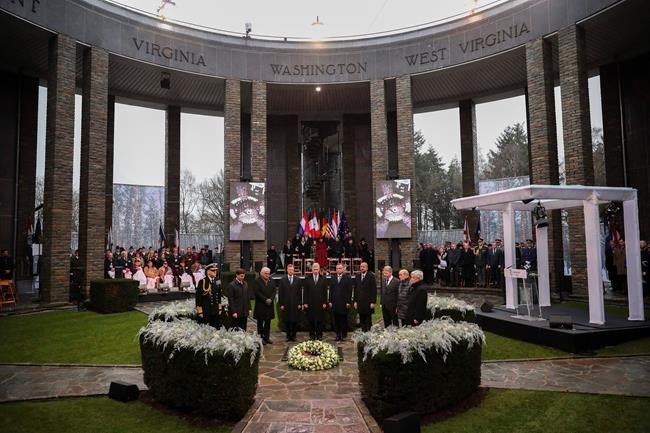
U.S. Secretary of Defence Mark Esper, second left, German President Frank-Walter Steinmeier, third left, Luxembourg's Grand Duke Henri, fourth left, Belgium's King Philippe, fifth left, Poland's President Andrej Duda, sixth left, European Council President Charles Michel, fourth right, and other authorities stand up during a minute of silence during a ceremony to commemorate the 75th anniversary of the Battle of the Bulge at the Mardasson Memorial in Bastogne, Belgium on Monday, Dec. 16, 2019. The Battle of the Bulge, also called Battle of the Ardennes, took place between Dec. 1944 and Jan. 1945 and was the last major German offensive on the Western Front during World War II. (AP Photo/Francisco Seco)
Republished December 16, 2019 - 1:29 PM
Original Publication Date December 16, 2019 - 1:06 AM
BASTOGNE, Belgium - Side by side, the Allies and former enemy Germany togethermarked the 75th anniversary of one of the most important battles in World War II — the Battle of the Bulge, which stopped Adolf Hitler's last-ditch offensive to turn the tide of the war.
At dawn on Dec. 16, 1944, over 200,000 German soldiers started the most unexpected breakthrough through the dense woods of Belgium and Luxembourg's hilly Ardennes. Making the most of the surprise move, the cold, freezing weather and wearied U.S. troops, the Germans pierced the front line so deeply it came to be known as the Battle of the Bulge.
Initially outnumbered, U.S. troops delayed the attack enough in fierce fighting to allow reinforcements to stream in and turn the tide of the battle by Christmas. After a month of fighting, the move into Germany was unstoppable.
U.S. Secretary of Defence Mark Esper paid tribute to over 19,000 U.S. troops who died in one of the bloodiest battles in the nation's history.
“Their efforts not only defended America but also ensured that the peoples of Europe would be free again," Esper said, calling the Battle of the Bulge “one of the greatest in American history."
U.S. Army veteran Malcolm “Buck” Marsh took the tributes in stride Monday as he addressed royalty, military leaders and top government officials.
“It is great to be here but I'm glad I'm not digging a foxhole," Marsh said.
Bent, slow, yet sturdy, the veterans returning to the battlefield continued to amaze the crowds. U.S. House Speaker Nancy Pelosi marveled at the composure they must have had during the battle when many were still teenagers.
She said European leaders also lauded the grit and courage of soldiers who were so young - and yet so willing to fight for the freedom of others.
“I said, 'Well, they didn't come here because you were Americans. They came here because they were Americans. And that's what we do,' " Pelosi told The Associated Press.
Even though German deaths also exceeded well over 10,000 in the battle that stretched deep into January, German President Frank-Walter Steinmeier took special time to thank the U.S. troops.
“On this day, we Germans would like to thank the United States of America. The American armed forces, together with their allies, liberated Europe and they also liberated Germany. We thank you," Steinmeier said.
“Those who died were victims of hatred, delusion, and a destructive fury that originated from my country," he said.
Germany is now an ally of the United States and its wartime partners in NATO. During the poignant ceremonies at the star-shaped Mardasson memorial in Bastogne, the current discord between the United States and several European allies over trade and security were never mentioned.
Even if it was a relatively warm 6 degrees Celsius (43 F) as opposed to the shivering conditions 75 years ago, the commemoration took place under leaden skies and rain with fog hanging low.
Hitler had hoped the advance would change the course of World War II by forcing U.S. and British troops to sue for peace, thus freeing Germany to focus on the rapidly advancing Soviet armies in the east.
Out of the blue at dawn, over 200,000 German troops counter-attacked across the front line in Belgium and Luxembourg, smashing into battle-weary U.S. soldiers positioned in terrain as foreign to them as it was familiar to the Germans.
Yet somehow, the Americans blunted the advance and started turning back the enemy for good, setting Allied troops on a roll that would end the war in Europe less than five months later.
This battle gained fame not so much for the commanders' tactics but for the resilience of small units hampered by poor communications that stood shoulder to shoulder to deny Hitler the quick breakthrough he so desperately needed. Even though the Americans were often pushed back, they were able to delay the German advance in its crucial initial stages.
“It was ultimately the intrepid, indomitable spirit of the American solider that brought victory," Esper said.
When the fortunes of war turned, it was most visible in the southern Ardennes town of Bastogne, where surrounded U.S. troops were cut off for days with little ammunition or food.
When Brig. Gen. Anthony C. McAuliffe of the 101st Airborne received a Dec. 22 ultimatum to surrender or face total destruction, he offered one of the most famous — and brief — replies in military history: “”Nuts." Four days later, U.S. troops broke the Nazi encirclement.
“News of their fierce defence quickly spread, boosting the morale of allied forces all along the Western Front,” Esper said.
After the fighting in the Battle of the Bulge ended on Jan. 28, 1945, Allied forces invaded Germany, eventually leading to the Nazi surrender and the end of the war in Europe.
___
Casert reported from Brussels. Photojournalist Virginia Mayo contributed from Hamm, Luxembourg.
News from © The Associated Press, 2019